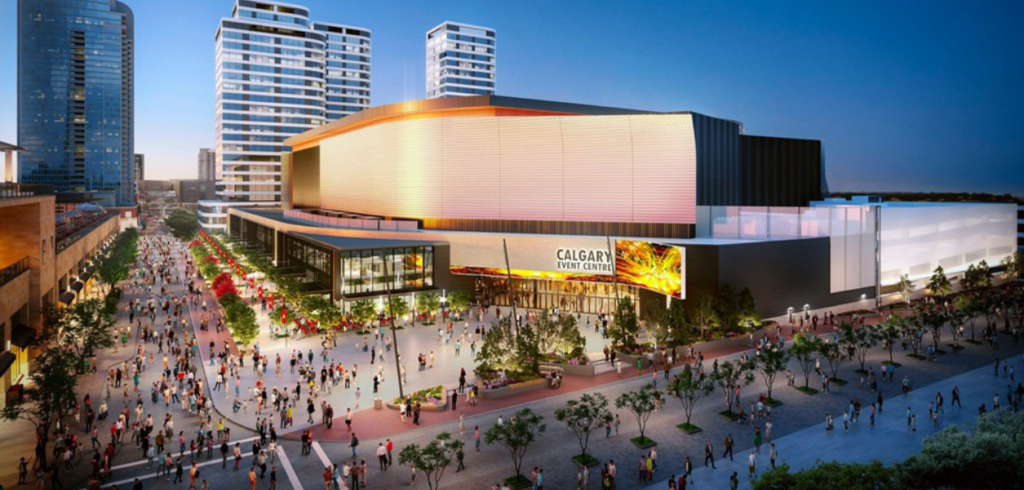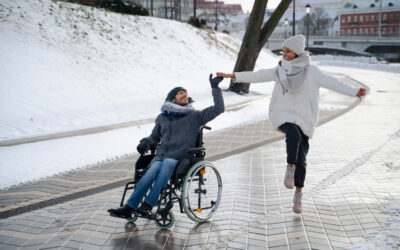
Photo via @Jeffdavisonyyc/Twitter
Crafting a Beacon of Inclusion: The New Calgary Arena & Event Centre
By: Garrett Crump | September 20, 2023 | Included by Design
In the heart of Calgary, amidst a whirlpool of discussions, debates, and deliberations, rises a promising edifice – the new arena and event centre, a beacon that has the potential to embody the true spirit of inclusivity and accessibility. While the funding saga has polarized public opinion, an undeniable opportunity lies ahead – an opportunity to correct the errors of the past and pave the way for an arena that stands as a hallmark of accessibility and inclusion.
Bridging Past Gaps: Learning from the Saddledome
The Saddledome, a revered institution in Calgary’s sporting culture, has had a long history of hosting fervent spectators who come together to cheer, celebrate, and unite under a common spirit. However, it also bore witness to the barriers faced by many, barriers that stemmed from its constrained accessibility. From limited wheelchair spaces to inadequate restroom facilities, the Saddledome echoed the challenges many arenas face in accommodating all patrons equitably.
As we bid farewell to the iconic Saddledome, it is vital to reflect on its shortcomings to foster a future where inclusivity isn’t just a buzzword but a tangible reality.
Laying the Foundation of Accessibility
The new arena presents an unmissable chance to incorporate state-of-the-art design principles that harmonize accessibility with aesthetic appeal. The architectural blueprint must prioritize ease of movement, not just within the seating areas but extending to all corners of the facility. Here’s how:
1. Inclusive Entrances and Exits: Incorporating entrances with ramp options and automated doors can ensure smooth transition for all individuals.
2. Navigable Corridors: Wider corridors with clear signage would facilitate easy navigation for everyone, but particularly for those who rely on wheelchairs and mobility aids.
3. Enhanced Restroom Facilities: Equipping restrooms with additional accessible stalls, lowered sinks, and proper handrails can foster a comfortable experience for all.
4. Seating for All: Designing multiple seating areas that cater to various needs, including spaces for mobility aids and wheelchairs and easy access seats.
Case Study: The AT&T Stadium
An inspirational starting point when considering how the new Calgary Arena and Event Centre can be better is examining the AT&T stadium in Arlington, Texas, home to the NFL’s Dallas Cowboys. This stadium is renowned for its inclusive design, featuring over 1,000 wheelchair accessible seats and offering sensory inclusion bags for individuals with autism and other sensory-processing needs. Their commitment to accessibility sets a benchmark in inclusive stadium design.
Fostering Inclusive Cultural Events
Beyond the structural components, the event centre should serve as a nurturing ground for a rich tapestry of cultural events that resonate with the principles of inclusivity. These events should not only be accessible to all but should also celebrate the diversity that Calgary embodies.
1. Interpreted Performances: Hosting events with sign language interpreters and captioning services would ensure the deaf and hard of hearing community can enjoy performances seamlessly.
2. Sensory-Friendly Events: Organizing events that are sensitive to individuals with sensory processing issues, by managing sound levels and lighting, can carve a welcoming space for all.
3. Community Engagement: Inviting diverse groups to partake in and contribute to the event programming can foster a sense of community ownership and pride. According to a survey by the Canadian Survey on Disability, over 22% of Canadians identified as having a disability. Incorporating Inclusive design features in new projects can be a testament to Calgary’s commitment to fostering community and respecting the dignity of all its members.
Case Study: The Barclays Center
A premier example of community engagement is the Barclays Center in Brooklyn, New York, whose initiatives have been commended for the community input regarding accessible design. The centre features elevators at all main entrances, a hearing assistance system, and service animals’ accommodation, offering an inclusive experience for their patrons.
Leveraging Technology for Enhanced Accessibility
Technology stands as a powerful ally in this mission. Integrating assistive technologies can significantly amplify the centre’s accessibility quotient.
1. Digital Signage: Employing digital signage with high contrast and large fonts can facilitate easy reading for individuals with visual improvements.
2. Assistive Listening Devices: Installing systems that enhance sounds clarity for individuals with hearing impairments can greatly enhance the auditory experience.
3, App-Based Guidance: Developing a mobile application that provides real time assistance and information on facility features can empower patrons to navigate the space with ease.
Collaborating with Experts
Should the arena and event centre have a vision of becoming an epitome of accessibility, this would be greatly enhanced by collaborating with experts in the field. Consulting with organizations like Included by Design would ensure the integration of proven strategies and methodologies that champion inclusivity at every step.
A Vision for the Future: Fostering Economic Benefit and Social Benefits
Creating an accessible arena and event centre goes beyond the moral imperative; it holds substantial economic potential. By fostering an inclusive space, the new centre stands to attract a broader audience base, translating to increased patronage and revenue streams. An Accenture report highlighted that companies with best practices in disability inclusion witnessed a 28% higher revenue and 30% stronger profits. Moreover, an inclusive event centre would serve as a catalyst in building stronger community ties, fostering unity in diversity.
Expert Opinion: Accessibility expert, Sinéad Burke, emphasizes the importance of inclusivity in design. in a TEDtalk, she mentions, “When we design for disability, we all benefit.” Taking a leaf from her insights, it is crucial that the new venue serves to offer comfortable and dignified experiences to all attendees, regardless of their physical abilities.
As the new arena and event centre in Calgary begins to take shape, the stirring of a promising revolution in accessibility and inclusivity is palpable. A centre that is not just a hub of sporting excellence but a beacon of cultural unity, a centre that welcomes all with open arms, breaking down barriers and bridging gaps.
Additional Data and Insights
To further underline the importance of why we push so hard for accessibility and inclusion to be a basis within design, here are some stats and insights:
1. Increased Employment Opportunities: According to a report by the Conference Board of Canada, enhancing accessibility can result in a 1.3% increase in employment, translating to 550,000 new jobs.
2. Boost in GDP: The same report estimated that improved accessibility could lead to a cumulative boost in Canada’s GDP by $366.5 billion over the next 20 years.
3. Consumer Spending: A study by the Return on Disability Group highlighted that consumers with disabilities have an estimated spending power of $1.9 Trillion globally, demonstrating the economic potential of fostering inclusivity.
Calgary stands on the cusp of a golden opportunity, an opportunity to craft a space that resonates with the spirit of inclusion, offering accessible and joyful experiences to one and all. Let us seize this moment to build not just an architectural marvel but a living testament to Calgary’s commitment to fostering a society where everyone feels included, where the spirit of togetherness thrives, transcending physical barriers and cultivating ties that bind us as a community, stronger and united.
To learn more about Included by Design’s process please click HERE and feel free to contact us to learn more.


